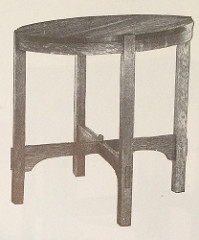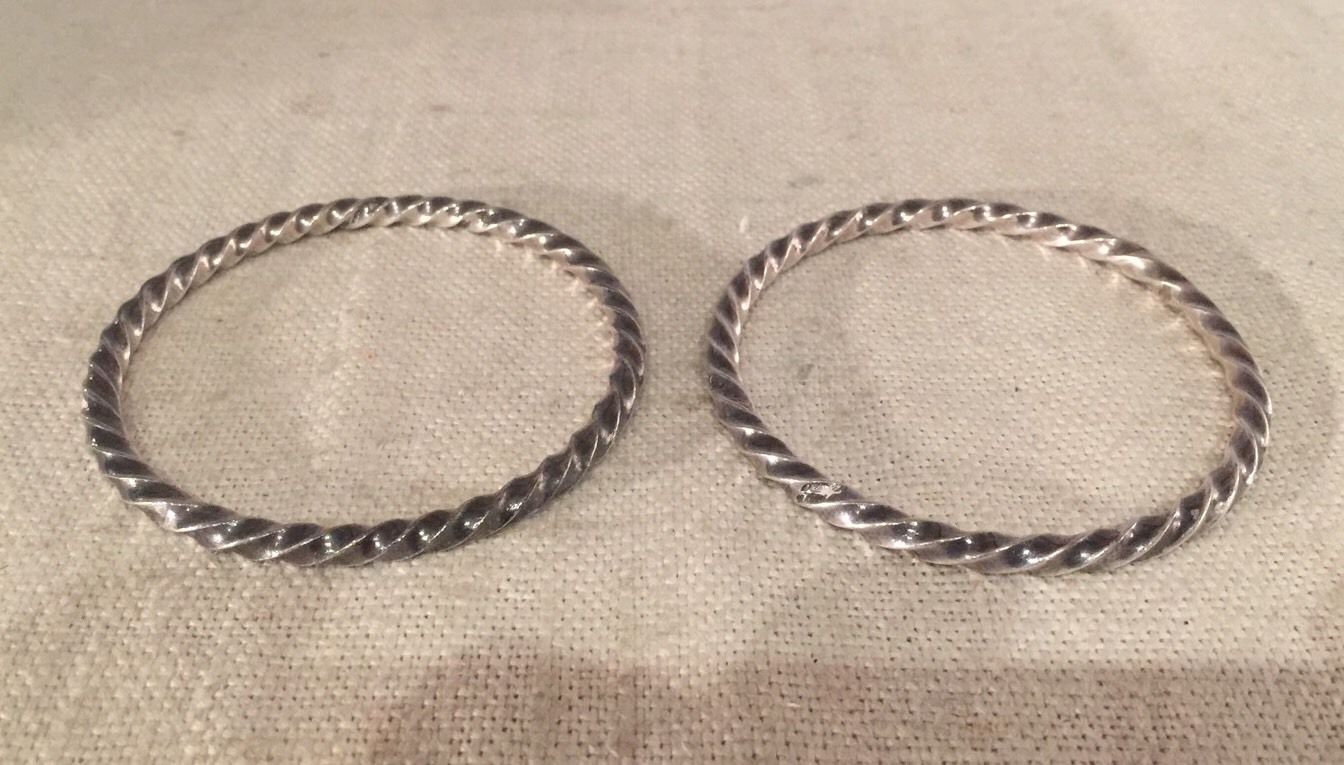Description: Table
Dimensions: 40" Diameter x 29" High
Info: Mission style furniture is characterized by broad, straight horizontal and vertical lines . The furniture is usually comprised of oak with a distinct dark finish. The designs are simple and elegant with little embellishment, illustrating the simplicity and durability of the pieces.
Tables are usually secured at intersections by joints called splines to strengthen the severe straight lines and plain surfaces. Handles and any trimmings are made from copper or iron. Tables can also include additional features such as drawers, extensions, and shelves.
Tables are usually secured at intersections by joints called splines to strengthen the severe straight lines and plain surfaces. Handles and any trimmings are made from copper or iron. Tables can also include additional features such as drawers, extensions, and shelves.
History: Gustav Stickley and his brothers, Charles and Albert, formed Stickley Brothers & Company in 1883, the same year in which Gustav married Eda Ann Simmons. Within five years, the company was dissolved and Stickley's ambitions led him to partner with Elgin Simonds, a salesman in the furniture trade, to form the firm of Stickley & Simonds in Binghamton, New York. During the 1890s, Stickley divided his efforts between his new enterprise and, with his brother Leopold, served as a foreman of furniture operations at the Auburn State Prison. In 1898 he orchestrated the removal of Simonds and formed the Gustav Stickley Company.
In the summer of 1900 he worked with Henry Wilkinson and, possibly, LaMont A. Warner (soon his first staff designer) to create his first Arts and Crafts works in an experimental line called the New Furniture. In 1901 he changed the name of his firm to the United Crafts, issued a new catalogue written by Syracuse professor Irene Sargent, and began to offer middle class consumers a host of progressive furniture designs in ammonia-fumed quartersawn white oak, as well as other mostly native woods. In October 1901, Stickley published the first issue of The Craftsman magazine, an important vehicle for promoting Arts and Crafts philosophy as well as the products of his factory within the context of articles, reviews, and advertisements for a range of products of interest to the homemaker.
Stickley's new furniture reflected his ideals of simplicity, honesty in construction, and truth to materials. Unadorned, plain surfaces were enlivened by the careful application of colorants so as not to obscure the grain of the wood and mortise and tenon joinery was exposed to emphasize the structural qualities of the works. Hammered metal hardware, in armor-bright polished iron or patinated copper emphasized the handmade qualities of furniture which was fabricated using both handworking techniques and modern woodworking machinery within Stickley's Eastwood, New York, factory (now a part of Syracuse, New York). Dyed leather, canvas, terry cloth and other upholstery materials complemented the designs.
Those ideals - simplicity, honesty, truth - were reflected in his trademark, which includes the Flemish phrase Als Ik Kan inside a joiner's compass. The phrase is translated 'if I can.' It is meant to convey the idea "if it can be done, I will do it."
His firm's work, both nostalgic in its evocation of handicraft and the pre-industrial era and proto-modern in its functional simplicity, was popularly referred to as being in the Mission style, though Stickley despised the term as misleading. In 1903 he changed the name of his company again, to the Craftsman Workshops, and began a concerted effort to market his works by then including furniture as well as textiles, lighting, and metalwork as Craftsman products. Ultimately, over 100 retailers across the United States represented the Craftsman Workshops.
In the summer of 1900 he worked with Henry Wilkinson and, possibly, LaMont A. Warner (soon his first staff designer) to create his first Arts and Crafts works in an experimental line called the New Furniture. In 1901 he changed the name of his firm to the United Crafts, issued a new catalogue written by Syracuse professor Irene Sargent, and began to offer middle class consumers a host of progressive furniture designs in ammonia-fumed quartersawn white oak, as well as other mostly native woods. In October 1901, Stickley published the first issue of The Craftsman magazine, an important vehicle for promoting Arts and Crafts philosophy as well as the products of his factory within the context of articles, reviews, and advertisements for a range of products of interest to the homemaker.
Stickley's new furniture reflected his ideals of simplicity, honesty in construction, and truth to materials. Unadorned, plain surfaces were enlivened by the careful application of colorants so as not to obscure the grain of the wood and mortise and tenon joinery was exposed to emphasize the structural qualities of the works. Hammered metal hardware, in armor-bright polished iron or patinated copper emphasized the handmade qualities of furniture which was fabricated using both handworking techniques and modern woodworking machinery within Stickley's Eastwood, New York, factory (now a part of Syracuse, New York). Dyed leather, canvas, terry cloth and other upholstery materials complemented the designs.
Those ideals - simplicity, honesty, truth - were reflected in his trademark, which includes the Flemish phrase Als Ik Kan inside a joiner's compass. The phrase is translated 'if I can.' It is meant to convey the idea "if it can be done, I will do it."
His firm's work, both nostalgic in its evocation of handicraft and the pre-industrial era and proto-modern in its functional simplicity, was popularly referred to as being in the Mission style, though Stickley despised the term as misleading. In 1903 he changed the name of his company again, to the Craftsman Workshops, and began a concerted effort to market his works by then including furniture as well as textiles, lighting, and metalwork as Craftsman products. Ultimately, over 100 retailers across the United States represented the Craftsman Workshops.
Item created by: Lethe on 2015-06-02 09:56:49. Last edited by gdm on 2018-01-09 10:54:55
If you see errors or missing data in this entry, please feel free to log in and edit it. Anyone with a Gmail account can log in instantly.
If you see errors or missing data in this entry, please feel free to log in and edit it. Anyone with a Gmail account can log in instantly.







